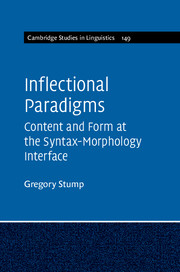Book contents
- Frontmatter
- Dedication
- Contents
- List of figures
- List of tables
- Acknowledgements
- List of abbreviations
- List of symbols and operators
- Introduction
- 1 What are inflectional paradigms?
- 2 Canonical inflectional paradigms
- 3 Morphosyntactic properties
- 4 Lexemes
- 5 Stems
- 6 Inflection classes
- 7 A conception of the relation of content to form in inflectional paradigms
- 8 Morphomic properties
- 9 Too many cells, too few cells
- 10 Syncretism
- 11 Suppletion and heteroclisis
- 12 Deponency and metaconjugation
- 13 Polyfunctionality
- 14 A theoretical synopsis and two further issues
- References
- Index
2 - Canonical inflectional paradigms
Published online by Cambridge University Press: 18 December 2015
- Frontmatter
- Dedication
- Contents
- List of figures
- List of tables
- Acknowledgements
- List of abbreviations
- List of symbols and operators
- Introduction
- 1 What are inflectional paradigms?
- 2 Canonical inflectional paradigms
- 3 Morphosyntactic properties
- 4 Lexemes
- 5 Stems
- 6 Inflection classes
- 7 A conception of the relation of content to form in inflectional paradigms
- 8 Morphomic properties
- 9 Too many cells, too few cells
- 10 Syncretism
- 11 Suppletion and heteroclisis
- 12 Deponency and metaconjugation
- 13 Polyfunctionality
- 14 A theoretical synopsis and two further issues
- References
- Index
Summary
In order to understand the characteristics of inflectional paradigms in the most systematic way possible, it will frequently be useful to draw upon the assumptions of canonical typology (Corbett 2005, 2009, Brown et al. 2013). The strategy of this approach to typology is
(a) to identify the dimensions of possible cross-linguistic variation in a given phenomenon and the logical endpoints of these dimensions; and
(b) to situate canonical types at the extremes of these dimensions, calibrating attested phenomena according to the degree and direction of their deviation from these canonical types.
By postulating the notion of a canonical inflectional paradigm, one can describe different kinds of paradigmatic phenomena as involving different kinds of deviation from this canonical ideal.
In Section 2.1, I discuss the notion of canonical inflection as originally characterized by Corbett 2009; this provides a basis for the narrower notion of a canonical inflectional paradigm, whose characteristics I discuss individually in Section 2.2 and summarize in Section 2.3.
Canonical typology and canonical inflection
I take the notion of canonical inflection proposed by Corbett 2009 as a starting point for defining the canonical inflectional paradigm. The characteristics that Corbett associates with canonical inflection involve both a comparison of contrasting cells belonging to the same paradigm and a comparison of corresponding cells across paradigms (of the same category). The three relevant comparisons involve (i) the morphotactics of word forms, (ii) a lexeme's expression as a stem, and (iii) the inflectional exponents of a word form's morphosyntactic properties.
Consider first the comparison of cells belonging to a single paradigm. In instances of canonical inflection, the word forms realizing a paradigm's cells all have the same morphotactic structure. The declensional paradigm of Turkish adam ‘man’ in Table 2.1 exemplifies this characteristic: every word form in this paradigm has the structure
[Stem – (number) – (case)],
where number and case are suffixal expressions of number and case and where the parentheses reflect the absence of overt number marking in the singular and the absence of overt case marking in the nominative. Besides having the same structure, all of the inflected word forms realizing a particular lexeme canonically exhibit the same stem; for example, all of the forms in Table 2.1 exhibit the stem adam.
- Type
- Chapter
- Information
- Inflectional ParadigmsContent and Form at the Syntax-Morphology Interface, pp. 31 - 42Publisher: Cambridge University PressPrint publication year: 2015



